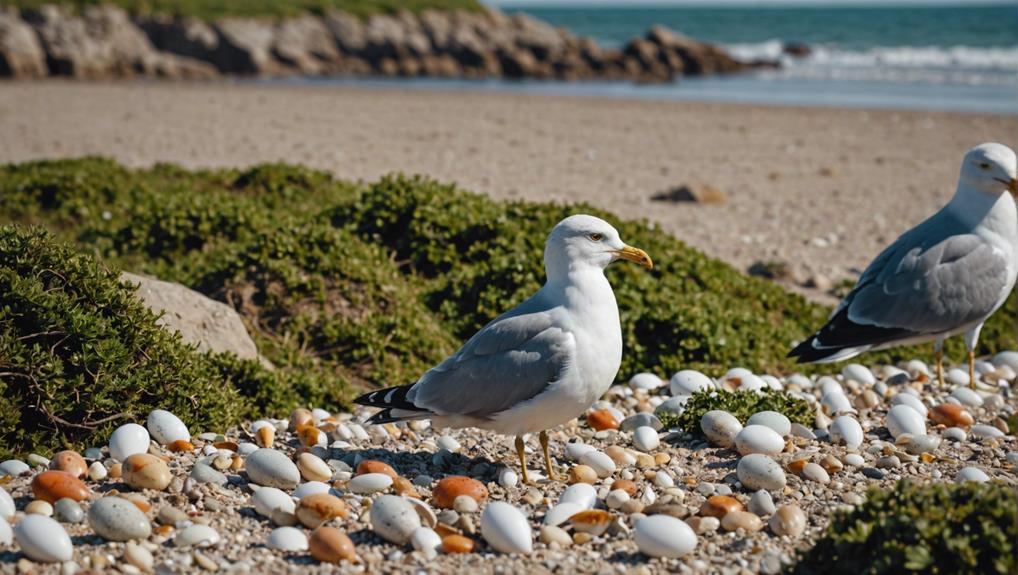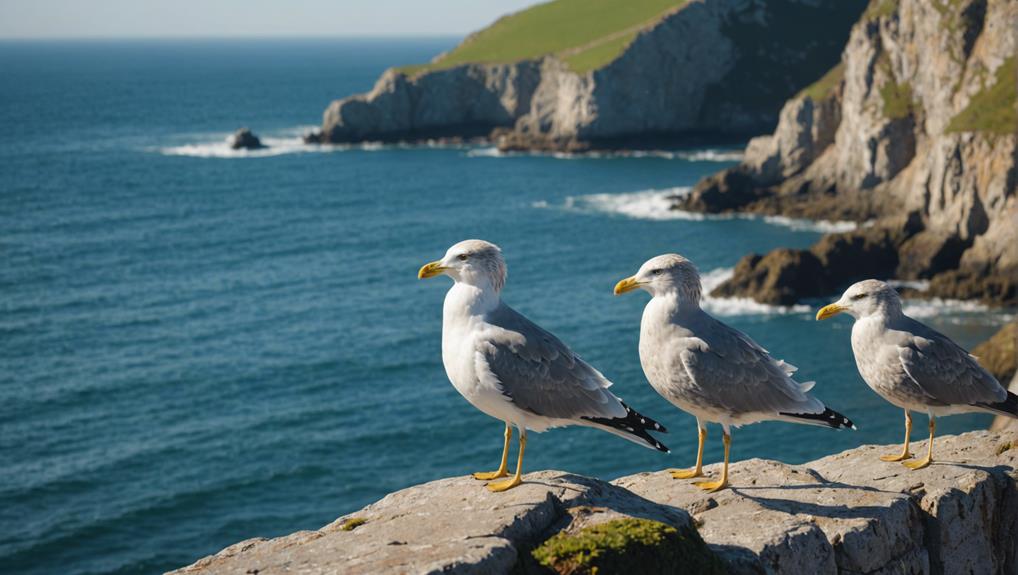The term 'seagull' broadly refers to different gull species, including the Herring Gull. Herring Gulls are characterized by pale grey wings, pink legs, and distinct white heads in summer that develop dark streaks in winter. They are highly adaptable, thriving in both coastal and urban environments. 'Seagull,' in contrast, encompasses a wide range of gull species, each with unique sizes, colors, and behaviors. Despite their broad similarities in scavenging and coastal habitats, appreciating the specific traits of each type, like those of the Herring Gull, reveals fascinating diversity. Exploring these distinctions can offer deeper insight into these intriguing birds.
Herring Gull Characteristics
Herring Gulls are large seabirds characterized by their pale grey wings, pink legs, and distinct white heads in summer that develop dark streaks during the winter. These birds are easily recognizable and widespread, making them a common sight along coastal areas and even in urban environments. Their adaptability is remarkable, allowing them to thrive in diverse habitats from grassy spaces to rooftops in bustling cities.
As opportunistic feeders, Herring Gulls consume a wide range of food, including fish, molluscs, invertebrates, and human food waste. This diet flexibility is a key factor in their success as a species. Their breeding habits also contribute to their resilience; Herring Gulls breed once a year between May and July, typically laying two or three eggs. Remarkably, their chicks leave the nest when only a few days old, showcasing an early start to independence.
Protected under the Wildlife and Countryside Act 1981, it is illegal to harm Herring Gulls, their chicks, nests, or eggs. Despite this protection, some populations have declined, placing them on the UK Red List. Their adaptability and legal safeguards highlight their importance within the ecosystem and the need for continued conservation efforts.
Seagull Variability
Seagull variability encompasses a wide range of species, each with distinct characteristics in plumage, size, and behavior, often leading to misconceptions in common terminology. The term 'seagull' is frequently used to describe different gull species found near coastal areas, yet it doesn't refer to a specific scientific classification. For instance, the Herring Gull is one of the most commonly encountered species that people refer to as seagulls, but this is just one example among many.
The diversity among seagulls is considerable. Different species display a diverse array of plumage, from the white and gray feathers of the Herring Gull to darker or more mottled patterns found in other types. Size also varies greatly, with some species being much larger or smaller than others. Moreover, their behaviors can differ widely; while some gulls are adept scavengers, others might exhibit more specialized feeding habits or nesting practices.
For precise identification, it is crucial to refer to specific species rather than using the general term 'seagull.' By doing so, one can appreciate the rich diversity and unique traits each species brings to the coastal ecosystems they inhabit.
Habitat Preferences

Understanding the habitat preferences of gull species is key to appreciating their ecological roles and behaviors. Herring Gulls, a specific species, are mostly found along coastal shorelines. These robust birds are often seen patrolling beaches and large open spaces near water, especially during winter months. Their adaptability allows them to thrive in diverse environments, including refuse dumps, where they scavenge for food.
In contrast, the term 'seagull' is a generic term used to describe a range of gull species that inhabit similar coastal areas. These seagulls share many of the same habitat preferences as Herring Gulls, frequenting beaches and refuse dumps. However, they are not limited to one specific species, making their presence more widespread and varied.
Nonbreeding adults and immature gulls, including Herring Gulls, commonly occupy areas where other seagulls are found, highlighting their overlapping habitat preferences. Despite the similarities, learning to recognize the beefy profile and distinct features of Herring Gulls can help differentiate them from other gull species often collectively referred to as seagulls.
Feeding Habits
Opportunistic feeding behaviors are a defining characteristic of both Herring Gulls and the diverse gull species collectively referred to as seagulls. These gulls exhibit highly adaptable feeding habits, allowing them to thrive in different environments.
Herring Gulls, in particular, are known for their opportunistic nature, consuming a wide range of food such as fish, molluscs, and human scraps. This adaptability is mirrored in many seagull species, which often exhibit pronounced scavenging habits near coastal areas.
Both Herring Gulls and seagulls can switch seamlessly between natural prey and human-provided food sources. They are frequently observed at refuse dumps, where discarded food offers an abundant supply. Coastal areas serve as rich feeding grounds for these birds, but they are equally adept at foraging in urban environments, taking advantage of leftover food and waste.
Their ability to exploit a variety of food sources, from beaches to city streets, is a confirmation of their evolutionary success. Understanding the dietary preferences and feeding behaviors of Herring Gulls and seagulls can help distinguish between the two in their natural habitats.
This insight not only highlights their adaptability but also underscores the impact of human activity on their feeding patterns.
Breeding and Nesting

Breeding and nesting practices of Herring Gulls and other gull species are remarkably synchronized, typically occurring between May and July each year. During this period, Herring gulls, like many seagulls, engage in their annual breeding cycle. They generally lay two or three eggs per year, carefully nesting in locations that offer some protection from predators. Seagulls, a term encompassing different gull species, follow a similar pattern, ensuring that their nesting practices align with the warmer and more food-abundant months.
The chicks of these gulls, including the Herring gull, are particularly active shortly after hatching. Only a few days old, these chicks often leave the nest, exploring the ground nearby. This behavior necessitates vigilant parental supervision to safeguard the young from potential predators. Gulls, including the Herring gull, strategically relocate their chicks to safer areas nearby to improve their chances of survival.
Importantly, these birds are protected under the Wildlife and Countryside Act of 1981. This legislation makes it illegal to harm gulls, their chicks, nests, or eggs, ensuring that their breeding and nesting activities can proceed without human interference. This protection is vital for maintaining the populations of these fascinating avian species.
Identification Tips
While the breeding and nesting habits of Herring Gulls and other gulls are similar, identifying these birds requires a closer look at specific physical and behavioral characteristics.
Here are some key identification tips to distinguish a Herring Gull from the general term 'seagull':
- Physical Appearance: Herring Gulls have a distinctive pale grey back and wings, which set them apart from other gull species often lumped together as 'seagulls.' Their legs are pink, a unique feature that aids in their identification.
- Seasonal Changes: During the summer, Herring Gulls boast a white head, which contrasts with the dark streaks that appear on their heads in the winter. This seasonal change is important for correct identification.
- Behavioral Traits: Herring Gulls have loud, distinctive calls. While many gulls are noisy, the specific tone and pattern of a Herring Gull's call can help differentiate this species from others found along coastal areas.
Understanding these differences is vital for bird enthusiasts and researchers alike. By paying attention to these details, one can accurately identify a Herring Gull among the diverse group of birds often referred to as seagulls.
Frequently Asked Questions
How Do You Identify a Herring Gull?
To identify a Herring Gull, look for its large size, pale grey wings, and pink legs.
In summer, its head is white, while in winter, it has dark streaks.
These gulls are commonly seen near water and urban areas, scavenging for food.
Herring Gulls are protected by law, so it is crucial to observe them without disturbing their nests or eggs.
Why Is It Called a Herring Gull?
The Herring Gull is named for its tendency to feed on herring fish along coastal shorelines. This dietary preference sets it apart from other gull species, making the name quite fitting.
How Can You Tell the Difference Between Gulls?
To differentiate between gull species, observe their physical characteristics and behaviors. Look at the color of their legs, wings, and back. Herring gulls, for example, have pink legs and a pale grey back.
Notice the head markings, which change seasonally. Also, pay attention to their size and vocalizations. By comparing these traits, you can accurately identify specific gull species and distinguish them from the general term 'seagull.'
Where Are Herring Gulls Most Common?
Herring Gulls are most common along coastal shorelines, where they can be seen feeding on beaches and at refuse dumps.
During the winter, these gulls often move to large open spaces near water, particularly nonbreeding adults and immature gulls.
Recognizing their distinct, beefy profiles can help in identifying other gull species.
Their adaptability to different environments makes them a prevalent sight in different coastal and inland areas.

